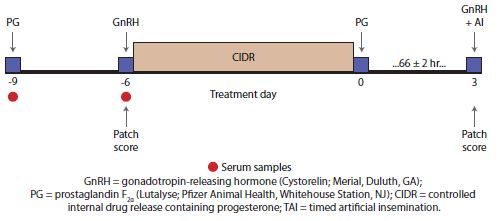



Evidence of Oestrus Before CIDR Insertion Does Not Influence Pregnancy Rate to Fixed-Timed Artificial Insemination in Beef Heifers
Attaching heat oestrus detection patches at the time of fixed-timed artificial insemination had little effect on conception, according to a team of beef production specialists.The following study was conducted by S.K. Johnson, M.A. Ward, O.L. Swanson and G.A. Perry and unveiled at the Kansas Cattlemen's Day in 2013.
Introduction
Protocols used for fixed-timed artificial insemination strive to synchronize growth of follicular waves and commonly do so by administration of gonadotropin-releasing hormone (GnRH) at the beginning of the treatment. The stage of the cycle at the time of GnRH injection influences the proportion of animals that respond, and cows respond more consistently than heifers. Variability in response to GnRH has been offered as an explanation for why why short-term fixed-timed insemination protocols tend to be less effective in heifers than cows. The dairy industry has used prostaglandin (PG) to “pre synchronize” cow ovulation before a protocol to improve the proportion of cows that initiate a new wave of follicular growth. Because of the additional cost in time and product, the beef industry has been reluctant to explore this approach.
South Dakota State University research has indicated that variability in onset of oestrus was reduced when PG was given 3 days before a controlled internal drug release (CIDR) protocol. A reduction in variability of the onset of oestrus may improve response to fixed-time artificial insemination. The objective of this study was to determine if the onset of oestrus prior to a PG 6-day CIDR protocol would improve pregnancy rates to fixed-time artificial insemination in beef heifers.
Diagram of a treatment protocol
Experimental Procedures
Ovulation was synchronized in 94 Angus and Angus crossbred heifers at 2 locations with a PG 6-day CIDR protocol (Figure 1). Body condition scores (1 = thin; 9 = very fat) were assigned at the start of the treatments. Heifers received 2 mL of Cystorelin (100 ug GnRH, Merial, Duluth, GA) and a CIDR (Pfizer Animal Health, Whitehouse Station, NJ) insert on day −6. On day 0, CIDR inserts were removed and 25 mg of PG (5 mL Lutalyse, Pfizer Animal Health) was administered intramuscularly.
A single fixed-timed insemination occurred 66 hours after CIDR insert removal. On day −9, all heifers received a heat-detection patch (Estrotect, Western Point, Inc., Apple Valley, MN) and 5 mL Lutalyse. On day −6, Estrotect patches were scored as activated, partially activated, or non-activated (Figure 2).
On day 0, missing or activated patches were replaced, and scoring occurred again at the time of artificial insemination. Serum concentrations of progesterone were determined in samples collected on day −9 and day −6. Serum samples with concentrations of progesterone ≥1 ng/ml were classified as high, and those with <1 ng/ml were classified as low.
Heat detection and artificial insemination continued (location 1) or bulls were turned in 10 days after fixed-timed artificial insemination (location 2). Pregnancy to artificial insemination was determined 34 to 36 days after fixed-time artificial insemination via transrectal ultrasonography.
Results and Discussion
Heifers averaged a body condition score of 6.0 and weighed 890 lb at the start of treatments (Table 1). Starting weight was greater (P < 0.01) for heifers in location 1 than location 2, but a similar proportion (91 per cent ) had at least 1 sample with concentrations of progesterone >1 ng/mL. On day −6 at the time of CIDR insertion, 30, 8, and 58 heifers had patches that were activated, partially activated, or non-activated, respectively (Figure 3).
Pregnancy rate to artificial insemination was similar regardless of patch activation at the time of CIDR insertion. Response to the first prostaglandin injection by day −6 was 40 per cent (activated or partially activated patches), which is within a normal range when a high proportion of animals are cycling at the time of injection.
At the time of artificial insemination, 60, 23, and 14 heifers had patches that were activated, partially activated, or non-activated, respectively (Figure 3). Pregnancy rate to artificial insemination was similar between heifers that had a fully activated patch and those with non activated patches. Heifers with partially activated patches had numerically lower pregnancy rates to artificial insemination but were not significantly different from the other groups.
Implications
The onset of oestrus as measured by patch activation prior to CIDR insertion did not result in higher pregnancy rates to fixed-timed artificial insemination compared with heifers with non-activated patches. Heifers that did not have activated heat detection patches at the time of fixed-timed artificial insemination conceived to timed artificial insemination as well as those with activated patches.
February 2014


.JPG)



